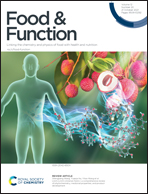A novel anticoagulant peptide discovered from Crassostrea gigas by combining bioinformatics with the enzymolysis strategy: inhibitory kinetics and mechanisms†
Abstract
A novel anticoagulant peptide (IEELEEELEAER) derived from oyster (Crassostrea gigas) was discovered by combining the emerging bioinformatics with the classical enzymolysis approach. The anticoagulant peptide drastically reduced the extrinsic clotting activity (49% residual PT activity) and impaired the intrinsic clotting activity (77% residual PT activity). Consistent with the clotting data, the thrombin peak height reduced to 88.7 from 123.4 nM, and the thrombin generation time delayed to 5.32 from 4.42 min when an extrinsic trigger was applied. The inhibitory kinetics of FXIa, FIXa, FXa, FIIa, and APC in a purified component system rationally explained the reduction of the extrinsic clotting activity and impairment of thrombin generation. Besides the inhibition of FXa and FIIa activity, the activation processes of FX and FII by an intrinsic/extrinsic tenase complex and prothrombinase were also damaged. The anticoagulant activity in the plasma system was the result of comprehensive inhibition of various factors. The research provided a frame for anticoagulant evaluation and inhibitory mechanism of bioactive peptides from food products.



 Please wait while we load your content...
Please wait while we load your content...